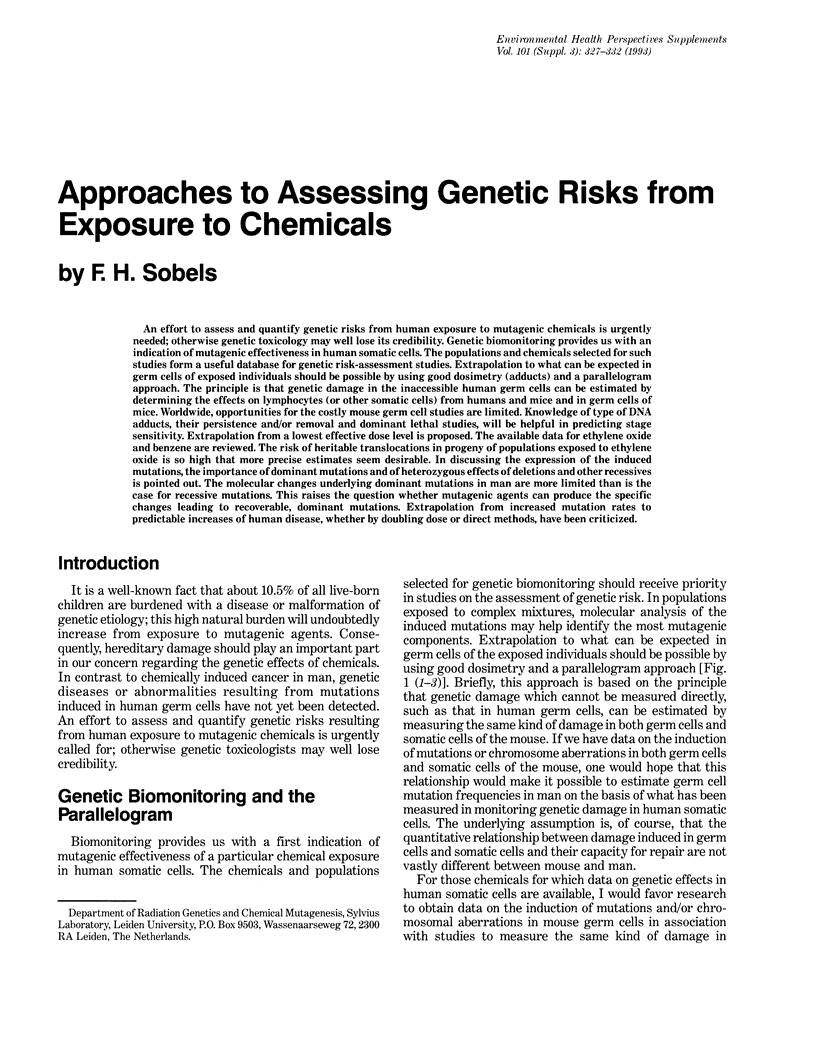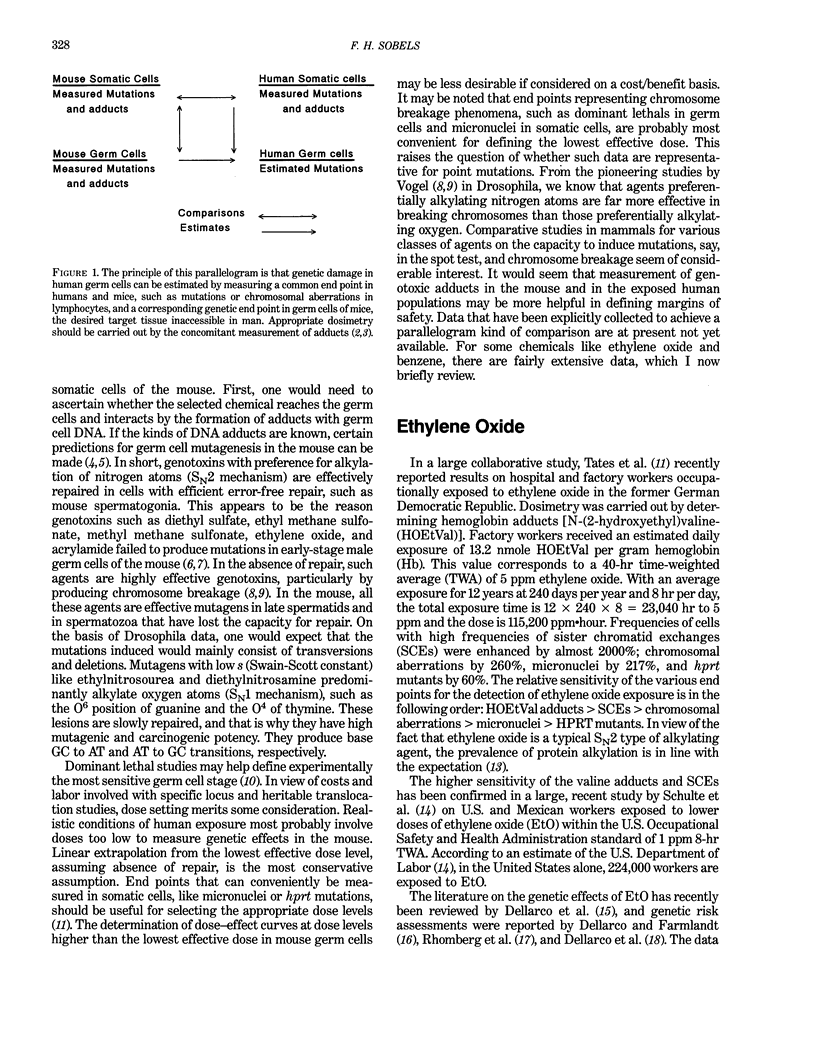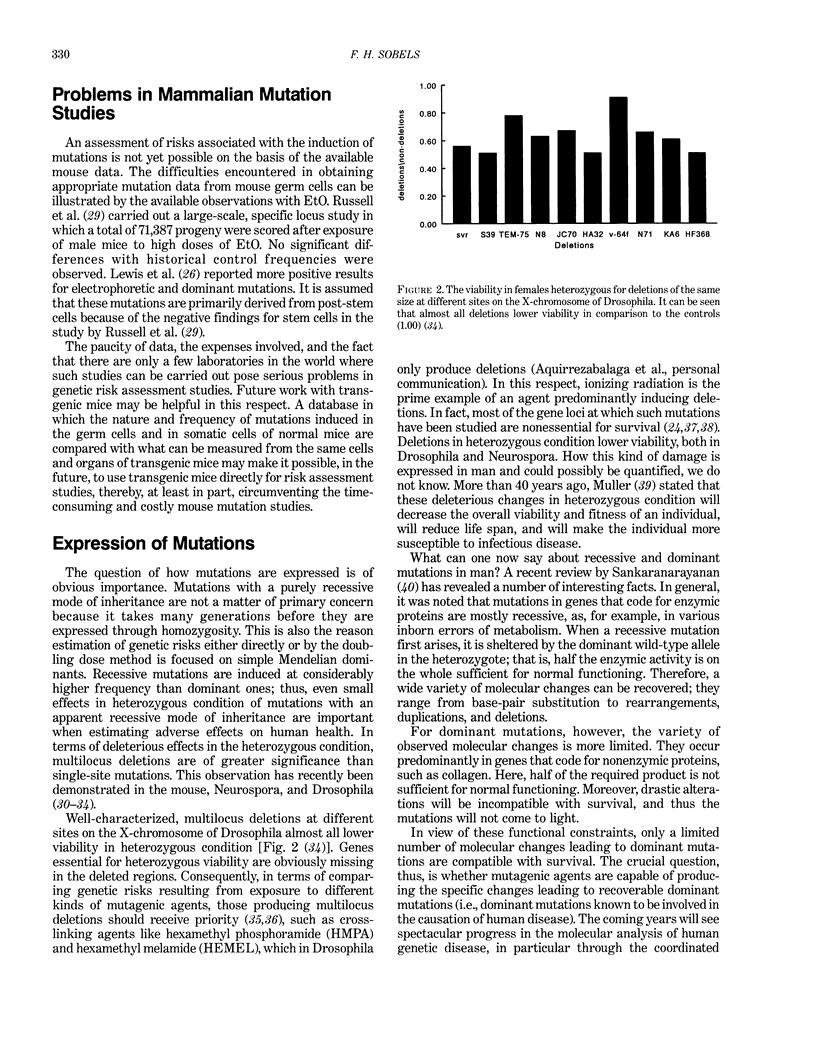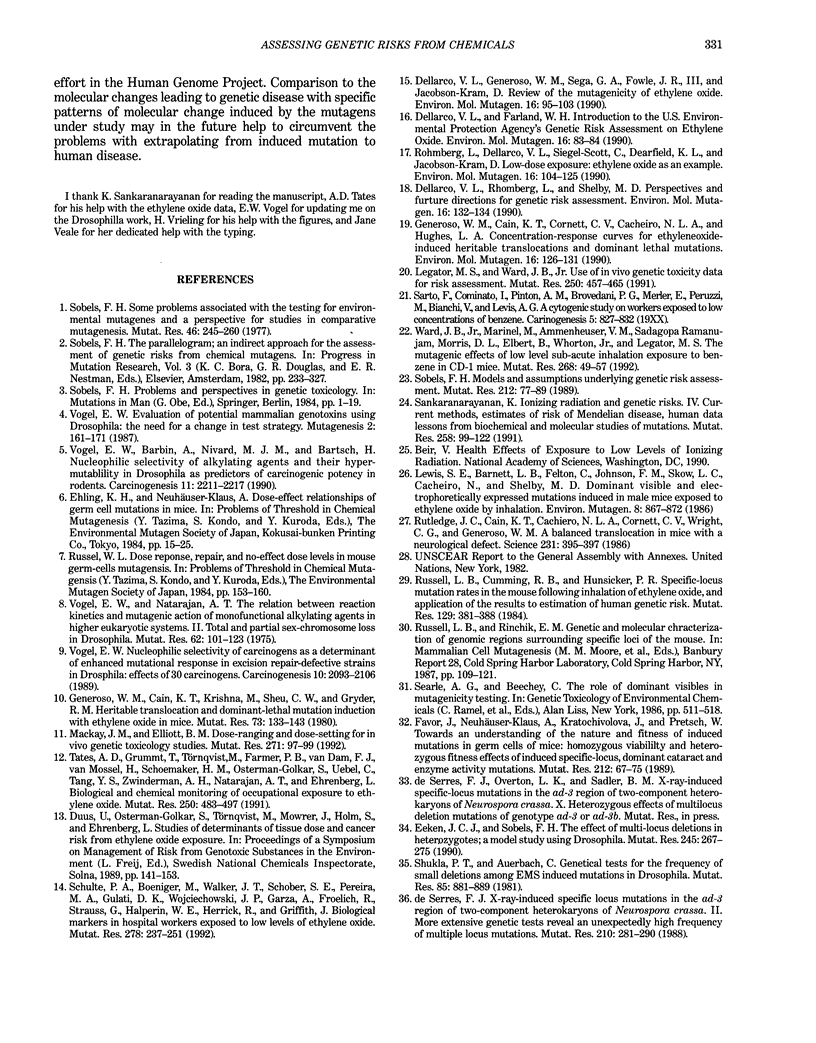Abstract
An effort to assess and quantify genetic risks from human exposure to mutagenic chemicals is urgently needed; otherwise genetic toxicology may well lose its credibility. Genetic biomonitoring provides us with an indication of mutagenic effectiveness in human somatic cells. The populations and chemicals selected for such studies form a useful database for genetic risk-assessment studies. Extrapolation to what can be expected in germ cells of exposed individuals should be possible by using good dosimetry (adducts) and a parallelogram approach. The principle is that genetic damage in the inaccessible human germ cells can be estimated by determining the effects on lymphocytes (or other somatic cells) from humans and mice and in germ cells of mice. Worldwide, opportunities for the costly mouse germ cell studies are limited. Knowledge of type of DNA adducts, their persistence and/or removal and dominant lethal studies, will be helpful in predicting stage sensitivity. Extrapolation from a lowest effective dose level is proposed. The available data for ethylene oxide and benzene are reviewed. The risk of heritable translocations in progeny of populations exposed to ethylene oxide is so high that more precise estimates seem desirable. In discussing the expression of the induced mutations, the importance of dominant mutations and of heterozygous effects of deletions and other recessives is pointed out. The molecular changes underlying dominant mutations in man are more limited than is the case for recessive mutations. This raises the question whether mutagenic agents can produce the specific changes leading to recoverable, dominant mutations. Extrapolation from increased mutation rates to predictable increases of human disease, whether by doubling dose or direct methods, have been criticized.
Full text
PDF





Selected References
These references are in PubMed. This may not be the complete list of references from this article.
- Dellarco V. L., Farland W. H. Introduction to the U.S. Environmental Protection Agency's genetic risk assessment on ethylene oxide. Environ Mol Mutagen. 1990;16(2):83–84. doi: 10.1002/em.2850160206. [DOI] [PubMed] [Google Scholar]
- Dellarco V. L., Generoso W. M., Sega G. A., Fowle J. R., 3rd, Jacobson-Kram D. Review of the mutagenicity of ethylene oxide. Environ Mol Mutagen. 1990;16(2):85–103. doi: 10.1002/em.2850160207. [DOI] [PubMed] [Google Scholar]
- Dellarco V. L., Rhomberg L., Shelby M. D. Perspectives and future directions for genetic risk assessment. Environ Mol Mutagen. 1990;16(2):132–134. doi: 10.1002/em.2850160210. [DOI] [PubMed] [Google Scholar]
- Eeken J. C., Sobels F. H. The effect of multi-locus deletions in heterozygotes; a model study using Drosophila. Mutat Res. 1990 Dec;245(4):267–275. doi: 10.1016/0165-7992(90)90156-e. [DOI] [PubMed] [Google Scholar]
- Favor J., Neuhäuser-Klaus A., Kratochvilova J., Pretsch W. Towards an understanding of the nature and fitness of induced mutations in germ cells of mice: homozygous viability and heterozygous fitness effects of induced specific-locus, dominant cataract and enzyme-activity mutations. Mutat Res. 1989 May;212(1):67–75. doi: 10.1016/0027-5107(89)90023-7. [DOI] [PubMed] [Google Scholar]
- Generoso W. M., Cain K. T., Cornett C. V., Cacheiro N. L., Hughes L. A. Concentration-response curves for ethylene-oxide-induced heritable translocations and dominant lethal mutations. Environ Mol Mutagen. 1990;16(2):126–131. doi: 10.1002/em.2850160209. [DOI] [PubMed] [Google Scholar]
- Generoso W. M., Cain K. T., Krishna M., Sheu C. W., Gryder R. M. Heritable translocation and dominant-lethal mutation induction with ethylene oxide in mice. Mutat Res. 1980 Nov;73(1):133–142. doi: 10.1016/0027-5107(80)90142-6. [DOI] [PubMed] [Google Scholar]
- Legator M. S., Ward J. B., Jr Use of in vivo genetic toxicity data for risk assessment. Mutat Res. 1991 Sep-Oct;250(1-2):457–465. doi: 10.1016/0027-5107(91)90202-y. [DOI] [PubMed] [Google Scholar]
- Lewis S. E., Barnett L. B., Felton C., Johnson F. M., Skow L. C., Cacheiro N., Shelby M. D. Dominant visible and electrophoretically expressed mutations induced in male mice exposed to ethylene oxide by inhalation. Environ Mutagen. 1986;8(6):867–872. doi: 10.1002/em.2860080609. [DOI] [PubMed] [Google Scholar]
- Mackay J. M., Elliott B. M. Dose-ranging and dose-setting for in vivo genetic toxicology studies. Mutat Res. 1992 Feb;271(1):97–99. doi: 10.1016/0165-1161(92)90036-l. [DOI] [PubMed] [Google Scholar]
- Rhomberg L., Dellarco V. L., Siegel-Scott C., Dearfield K. L., Jacobson-Kram D. Quantitative estimation of the genetic risk associated with the induction of heritable translocations at low-dose exposure: ethylene oxide as an example. Environ Mol Mutagen. 1990;16(2):104–125. doi: 10.1002/em.2850160208. [DOI] [PubMed] [Google Scholar]
- Russell L. B., Cumming R. B., Hunsicker P. R. Specific-locus mutation rates in the mouse following inhalation of ethylene oxide, and application of the results to estimation of human genetic risk. Mutat Res. 1984 Dec;129(3):381–388. doi: 10.1016/0027-5107(84)90093-9. [DOI] [PubMed] [Google Scholar]
- Rutledge J. C., Cain K. T., Cacheiro N. L., Cornett C. V., Wright C. G., Generoso W. M. A balanced translocation in mice with a neurological defect. Science. 1986 Jan 24;231(4736):395–397. doi: 10.1126/science.3941902. [DOI] [PubMed] [Google Scholar]
- Sankaranarayanan K. Ionizing radiation and genetic risks. I. Epidemiological, population genetic, biochemical and molecular aspects of Mendelian diseases. Mutat Res. 1991 Jul;258(1):3–49. doi: 10.1016/0165-1110(91)90027-s. [DOI] [PubMed] [Google Scholar]
- Sankaranarayanan K. Ionizing radiation and genetic risks. II. Nature of radiation-induced mutations in experimental mammalian in vivo systems. Mutat Res. 1991 Jul;258(1):51–73. doi: 10.1016/0165-1110(91)90028-t. [DOI] [PubMed] [Google Scholar]
- Sankaranarayanan K. Ionizing radiation and genetic risks. III. Nature of spontaneous and radiation-induced mutations in mammalian in vitro systems and mechanisms of induction of mutations by radiation. Mutat Res. 1991 Jul;258(1):75–97. doi: 10.1016/0165-1110(91)90029-u. [DOI] [PubMed] [Google Scholar]
- Sankaranarayanan K. Ionizing radiation and genetic risks. IV. Current methods, estimates of risk of Mendelian disease, human data and lessons from biochemical and molecular studies of mutations. Mutat Res. 1991 Jul;258(1):99–122. doi: 10.1016/0165-1110(91)90030-y. [DOI] [PubMed] [Google Scholar]
- Schulte P. A., Boeniger M., Walker J. T., Schober S. E., Pereira M. A., Gulati D. K., Wojciechowski J. P., Garza A., Froelich R., Strauss G. Biologic markers in hospital workers exposed to low levels of ethylene oxide. Mutat Res. 1992 Apr;278(4):237–251. doi: 10.1016/s0165-1218(10)80003-5. [DOI] [PubMed] [Google Scholar]
- Searle A. G., Beechey C. The role of dominant visibles in mutagenicity testing. Prog Clin Biol Res. 1986;209B:511–518. [PubMed] [Google Scholar]
- Sobels F. H. Models and assumptions underlying genetic risk assessment. Mutat Res. 1989 May;212(1):77–89. doi: 10.1016/0027-5107(89)90024-9. [DOI] [PubMed] [Google Scholar]
- Sobels F. H. Some problems associated with the testing for environmental mutagens and a perspective for studies in "comparative mutagenesis". Mutat Res. 1977 Aug;46(4):245–260. doi: 10.1016/0165-1161(77)90001-2. [DOI] [PubMed] [Google Scholar]
- Tates A. D., Grummt T., Törnqvist M., Farmer P. B., van Dam F. J., van Mossel H., Schoemaker H. M., Osterman-Golkar S., Uebel C., Tang Y. S. Biological and chemical monitoring of occupational exposure to ethylene oxide. Mutat Res. 1991 Sep-Oct;250(1-2):483–497. doi: 10.1016/0027-5107(91)90205-3. [DOI] [PubMed] [Google Scholar]
- Vogel E. W., Barbin A., Nivard M. J., Bartsch H. Nucleophilic selectivity of alkylating agents and their hypermutability in Drosophila as predictors of carcinogenic potency in rodents. Carcinogenesis. 1990 Dec;11(12):2211–2217. doi: 10.1093/carcin/11.12.2211. [DOI] [PubMed] [Google Scholar]
- Vogel E. W. Evaluation of potential mammalian genotoxins using Drosophila: the need for a change in test strategy. Mutagenesis. 1987 May;2(3):161–171. doi: 10.1093/mutage/2.3.161. [DOI] [PubMed] [Google Scholar]
- Vogel E. W. Nucleophilic selectivity of carcinogens as a determinant of enhanced mutational response in excision repair-defective strains in Drosophila: effects of 30 carcinogens. Carcinogenesis. 1989 Nov;10(11):2093–2106. doi: 10.1093/carcin/10.11.2093. [DOI] [PubMed] [Google Scholar]
- Vogel E., Natarajan A. T. The relation between reaction kinetics and mutagenic action of mono-functional alkylating agents in higher eukaryotic systems. II. Total and partial sex-chromosome loss in Drosophila. Mutat Res. 1979 Aug;62(1):101–123. doi: 10.1016/0027-5107(79)90224-0. [DOI] [PubMed] [Google Scholar]
- Ward J. B., Jr, Ammenheuser M. M., Ramanujam V. M., Morris D. L., Whorton E. B., Jr, Legator M. S. The mutagenic effects of low level sub-acute inhalation exposure to benzene in CD-1 mice. Mutat Res. 1992 Jul;268(1):49–57. doi: 10.1016/0027-5107(92)90082-d. [DOI] [PubMed] [Google Scholar]
- de Serres F. J. X-ray-induced specific-locus mutations in the ad-3 region of two-component heterokaryons of Neurospora crassa. II. More extensive genetic tests reveal an unexpectedly high frequency of multiple-locus mutations. Mutat Res. 1989 Feb;210(2):281–290. doi: 10.1016/0027-5107(89)90089-4. [DOI] [PubMed] [Google Scholar]


